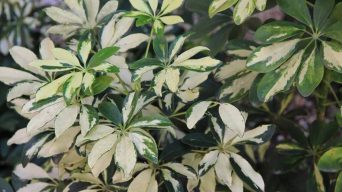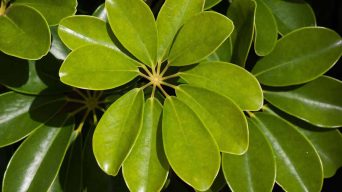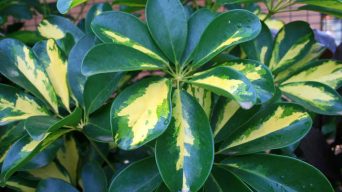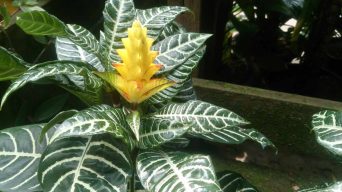Schefflera, commonly known as the umbrella plant or umbrella tree, is a popular houseplant because it is easy to care for and can tolerate many growing conditions.
However, one common problem with Schefflera houseplants is that they can become leggy over time.
Leggy plants have long, thin stems with few leaves and can be unsightly. This problem is usually caused by too little light.
If your Schefflera plant has become leggy, don’t despair! There are a few simple things you can do to fix the problem. Here you will find everything you need to know about how to fix a leggy umbrella plant.
What Causes a Schefflera to Become Leggy?
There are a few reasons why your Schefflera may become leggy.
The most common reasons are:
1. Not Enough Light
If your Schefflera isn’t getting enough light, it will become leggy as it stretches to try and reach an area with more light.
Umbrella plants are native to tropical areas and need bright indirect light to thrive.
They need at least 4 hours of indirect light daily. If your Schefflera tree is in a low-light area, it will become leggy, and the leaves will start to turn yellow.
Plants need light to photosynthesize and produce food. Without enough light, they will become weak and leggy.
2. Too Much Fertilizer
If you’re fertilizing your umbrella plant too often or using a fertilizer that’s too high in nitrogen, it can cause the plant to become leggy.
Fertilizer is like food for plants. It’s essential for their growth, but too much of it can be harmful. Umbrella plants are fast-growing, and they don’t need a lot of fertilizer.
You should only fertilize them once a month during the growing season.
If you fertilize them more often, it can cause the plant to become leggy and the leaves to turn yellow.
Also, ensure you’re using a fertilizer that’s low in nitrogen. Too much nitrogen will cause the plant to grow too quickly and become leggy.
3. Lack of Pruning
Pruning is an essential part of caring for an umbrella plant. If you don’t prune it, it will become leggy, and the leaves will start to yellow.
Pruning helps to encourage new growth and keeps the plant compact. It also helps to prevent the plant from becoming too leggy.
An umbrella tree must be pruned annually to keep it healthy and prevent it from becoming leggy.
How To Tell if Your Umbrella Plant is Leggy
There are a few signs that your umbrella plant is leggy:
1. The Stems Are Long and Thin
The first sign of a leggy umbrella plant is long, thin stems. The stems will be much longer than they should be, and they will be very thin.
When an umbrella plant grows in low-light conditions, it will stretch to try and reach an area with more light. This causes the stems to become long and thin.
2. There Are Fewer Leaves Than Usual
Another sign of a leggy umbrella plant is that there are fewer leaves than usual.
The leaves will be smaller than usual and spaced further apart on the stems.
This is because the plant is not getting enough light and cannot photosynthesize properly.
The plant will use its energy to try and grow taller to reach an area with more light. This will cause the leaves to become fewer and smaller.
3. The Leaves Are Yellow or Pale Green
If the leaves of your umbrella plant are yellow or pale green, it’s a sign that the plant is not getting enough light.
When a plant doesn’t get enough light, it will become leggy, and the leaves will start to turn yellow or pale green.
The discoloration is caused by the plant’s inability to photosynthesize properly, which is essential for its growth.
4. The Plant Is Growing Slowly
If your umbrella plant is growing slowly, it’s a sign that it’s not getting enough light.
Umbrella plants are fast-growing and need at least 4 hours of indirect light daily. The plant will grow slowly and become leggy if it is in a low-light area.
This is because the plant cannot photosynthesize properly and cannot produce the energy it needs to grow.
5. The Plant Is Drooping
If your umbrella plant is drooping, it’s a sign that it’s not getting enough light.
The leaves of the plant will be drooping down, and the stems will be weak. This is because the plant is not able to photosynthesize correctly, and it’s not able to produce the energy it needs.
The plant cannot hold up its leaves and will droop down.
6. The Plant Is Falling Over
If your umbrella plant is falling over, it’s a sign that it’s not getting enough light.
The plant’s stems will be weak, and they will be unable to support the leaves. This is because the plant is not able to photosynthesize correctly, and it’s not able to produce the energy it needs.
Without enough energy, the plant will not support its weight and start to fall over.
7. The Plant Looks Weak and Unhealthy
If your umbrella plant looks weak and unhealthy, it’s a sign that it’s not getting enough light.
The leaves will be pale, and they will be spaced far apart on the stems. The plant will look overall weak and unhealthy.
The plant cannot photosynthesize effectively, leaving it with insufficient energy.
How To Fix a Leggy Umbrella Plant
When an umbrella plant becomes leggy, it’s essential to take action so that the plant doesn’t become too weak and unhealthy.
Here are a few ways to fix a leggy umbrella plant:
1. Move the Plant to a Bright Area
The first step is to move the plant to a bright area. Umbrella plants need at least 4 hours of bright indirect light daily to grow correctly.
If the plant is in a low-light area, it will become leggy, and the leaves will start to turn yellow or pale green.
Indoor umbrella plants can be placed near a bright window, but ensure that the direct sunlight doesn’t hit the leaves, as this can scorch them.
An east- or west-facing window is ideal as it will provide bright indirect sunlight for the plant.
Outdoor umbrella plants need to be placed in an area that receives partial sun to full sun.
If the plant is in too much shade, it will become leggy, and the leaves will start to turn yellow or pale green.
A spot that receives partial sun to full sun is ideal as it will provide the plant with the bright light it needs to grow properly.
2. Prune the Plant
Pruning is a great way to fix a leggy umbrella plant. You will encourage the plant to grow fuller and healthier by pruning it.
Umbrella plants must be pruned every few months to keep them from becoming leggy.
How to Prune a Leggy Umbrella Plant
To prune a leggy umbrella plant, start by removing any leaves that are yellow or pale green. These leaves cannot photosynthesize properly and are taking energy away from the rest of the plant.
Next, trim back the plant stems to be about 6 inches shorter. This will encourage the plant to put energy into growing new stems and leaves.
Finally, prune any dead or dying stems from the plant. These stems cannot give the plant the energy it needs to grow properly.
3. Cut Back on Fertilizer
If you fertilize your umbrella plant, you may be doing it too much. Too much fertilizer can cause the plant to become leggy.
Fertilizer contains nitrogen which encourages the plant to grow. However, too much nitrogen can cause the plant to grow too fast and become leggy.
It’s best to fertilize your umbrella plant every 2 weeks during the spring and summer. Use a half-strength fertilizer solution to the soil around the plant.
You can fertilize your umbrella plant every month during the fall and winter months. Again, use a half-strength fertilizer solution and apply it to the soil around the plant.
4. Flush the Soil
If your plant is getting too much fertilizer, you can flush the soil to remove the excess.
To flush the soil, water the plant until the water starts to run out of the bottom of the pot. This will help to remove any excess fertilizer that might be in the soil.
The excess fertilizer can build up in the soil and cause the plant to become leggy.
How To Prevent a Leggy Schefflera Plant
You can do a few things to prevent your umbrella plant from becoming leggy.
1. Place Your Plant in a Bright Spot
Umbrella plants need bright, indirect light to thrive. If your plant is not getting enough light, it will become leggy as it stretches towards the light source.
Place your umbrella plant near a window that will get bright indirect light. East- or west-facing windows are ideal.
Outdoor umbrella plants will also do well in bright, indirect light. Just ensure they’re not in direct sunlight, which can scorch the leaves.
2. Turn Your Plant Regularly
When your plant only gets light from one direction, it will start to lean toward the light source.
To prevent this, turn your plant every week or so so that all sides get an equal amount of light. This will help your plant grow evenly.
3. Prune Your Plant Regularly
Pruning your umbrella plant will encourage it to branch out and become fuller.
When you prune, cut the stem back to just above a leaf node (the point where the leaves attach to the stem).
Remove any yellow or brown leaves and any stems that are longer than the others.
Prune your plant every few months to keep it from becoming leggy.
4. Don’t Overfertilize
Umbrella plants don’t need a lot of fertilizer to thrive. Too much fertilizer can cause your plant to become leggy.
Fertilize your umbrella plant once a month during the growing season (spring and summer) with a balanced liquid fertilizer diluted to half strength.
Avoid high nitrogen fertilizers, as they can promote leggy growth.
Final Thoughts
A leggy umbrella plant is probably not getting enough light. It’s a common problem, but it’s easy to fix. Move your plant to a brighter location; you should see new growth in no time.
If your umbrella plant is still leggy after moving it to a brighter location, you may need to prune it back. This will encourage new growth and help your plant to become fuller and more compact.
Remember that umbrella plants are tropical plants that need warm temperatures to thrive. If your plant is in a cold spot, it may never grow as full and lush as you want it to be.
If you follow these tips, you should be able to fix a leggy umbrella plant and get it looking its best again in no time!







